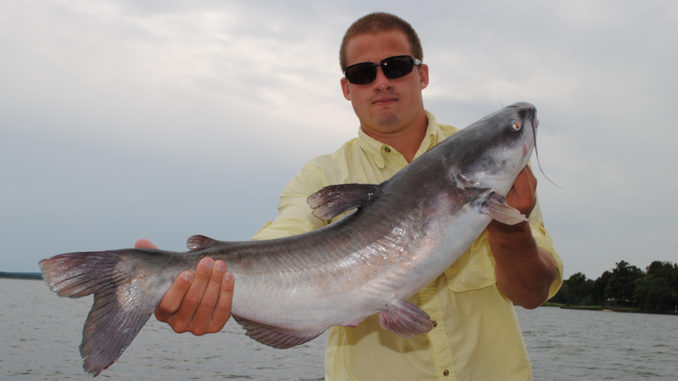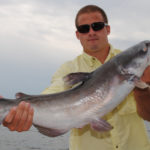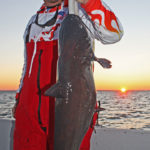
Despite decline, blue cats are still a great fishery
The big news for April is that the South Carolina General Assembly passed a bill last fall changing how blue catfish will be managed in the Santee Cooper reservoirs, and the changes will take effect April 1.
These changes are something all catfishermen need to know and understand. What was planned to be a regulation to rebuild the great blue catfish fishery on Lake Marion and Lake Moultrie turned into quite a controversy.
The new regulations limit fishermen to no more than two blue catfish daily greater than 32 inches long on Lake Marion, Lake Moultrie, or the upper reaches of the Santee, Congaree or Wateree rivers. It also sets a daily possession limit of 25 fish from those same areas that applies to all methods of taking and all licenses.
The legislation that was passed also stipulates that the S.C. Department of Natural Resources make a study of the blue catfish fishery on the Santee River and Cooper River systems and make recommendations on any needed modifications on or before Jan. 1, 2018. There’s also a “sunset clause” in the bill that states: “This act takes effect April 1, 2015, and shall be automatically repealed on June 30, 2018, unless reauthorized by a joint resolution for that specific purpose.”
Recommendations for new size and creel limits for blue catfish were made by the SCDNR after a series of public presentations. Resource users and the SCDNR recognized a decline in blue catfish abundance and a need to reduce the present level of harvest to ensure a return to the quality fishery anglers had come to expect. While some huge blue catfish continue to be caught, the overall fishery is not producing the numbers it once did. This downturn has largely been attributed to poor reproduction associated with the long-term drought of the decade from 2000 to 2010. Given the low level of successful reproduction, overfishing became a problem.
A citizens group submitted one recommendation that was much more-restrictive than the SCDNR’s recommendations. Eventually, the legislature passed a bill that was far less restrictive than either recommendation, and many feel there were political motivations behind the changes did not have the best public interest at heart.
While opinions may fly and tempers sometimes flare when change is implemented, the basic premise of any regulation should be based on sound conservation principles regardless of species. A change should be motivated by what is best for the resource, and it should be insulated from uninformed, long-distance political influence. In that way, the sportsmen of South Carolina who are served by the legislature and SCDNR will have the best-possible opportunity to enjoy the resource and harvest as appropriate, knowing the regulations protect the resource.
In most states, the decision-making process belongs to the natural resources agency designated to manage those resources. Sportsmen in other states certainly hold their agencies accountable for the decision making, but decisions are made by professionals who have the education, training, experience, job motivation and generally a love of the outdoors already instilled.
No system is perfect, but it makes sense to me that professionals in the designated field need to be making decisions along with active, advisory groups of sportsmen.
While the fishing for blue catfish is not as great as it has been, was, remember it was “world-class” fishing, and by many standards it’s still excellent, especially for big fish.
Scott Lamprecht, an SCDNR fisheries biologist, summed up the current status well with a direct comparison of Santee Cooper with another well know blue catfish fishery.
“The commercial harvest of catfish from the Santee Cooper lakes right now is greater than the commercial harvest of blue catfish from the Mississippi River along the entire border of Missouri,” Lamprecht said. “That’s significant.”
Buster Rush, who guides for catfish and crappie, said catfish will generally be caught in two basic patterns in April.
“The most-exciting action will be the windy days when the wind pushes the bait and catfish into shallow water,” Rush said. “We’ll get just off the shallow area and saturate it with baits. Action will typically be fast, and we’ll catch some big fish in the shallow water.”
Rush (803-432-5010) said plenty of catfish can be caught on the pleasant, warm, non-windy days of April.
“On days when the wind is not howling, we’ll typically find catfish a little deeper,” he said. “They haven’t left for the real deep water, and the ledges, humps and slightly deeper holes will hold plenty of blue catfish. Also, flatheads and channel catfish will begin to be caught more frequently during April.
“Cut herring and shad will be great for the blues and for channel catfish. Occasionally, we’ll catch a flathead on fresh cut bait but live bait is often best for the big flatheads.”
Guide Andy Pack out of Packs Landing said crappie fishing will be going strong, with a lot of fish still in shallow water and some moving back to mid-depths in 6 to 10 feet of water.
“This is a time when crappies have usually left the real shallow water and are beginning to get on cover a little deeper,” he said. “Both jigs and minnows will produce excellent results.”
Pack (803-452-5514) said stripers, largemouth bass, shellcrackers and bream are typically all on a good bite during April.
“For striper fishing, we’ve got the best of both worlds, because by early April, some stripers have spawned and are coming back downstream,” Pack said. “But plenty are still moving upriver, so we literally have them coming and going. This is the time of year when we use live bait more often, but I’ll fish both cut and live bait. Typically, cut bait works great in the early season and live bait as the fish return.
“April is usually the prime shellcracker bedding month,” he said. “Look for them around cypress trees and aquatic vegetation,” he said. “The largemouth fishing is still excellent in shallow water on a wide variety of lures.”







Be the first to comment